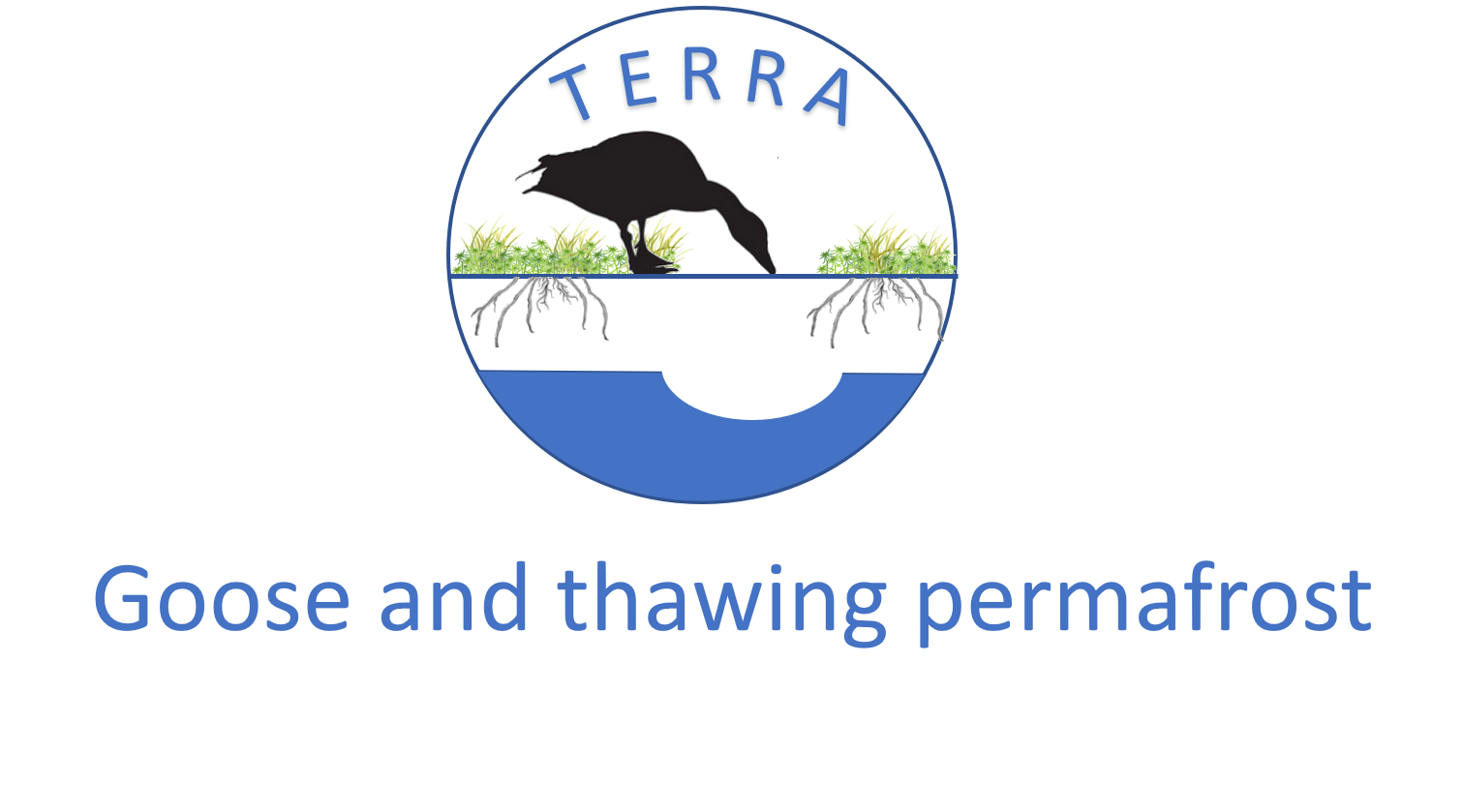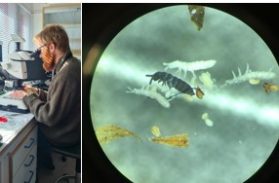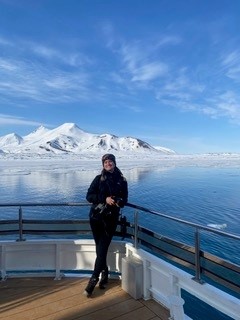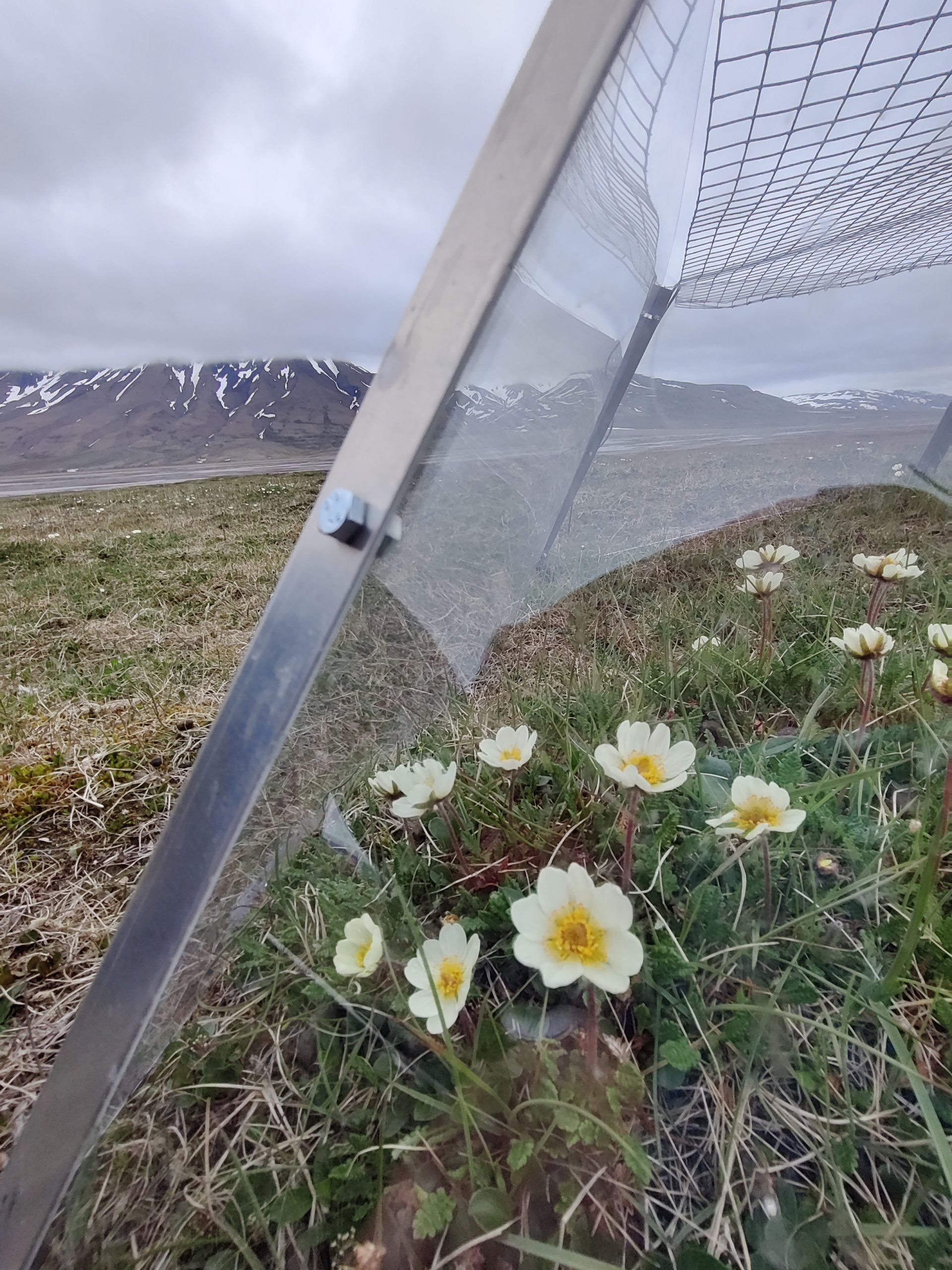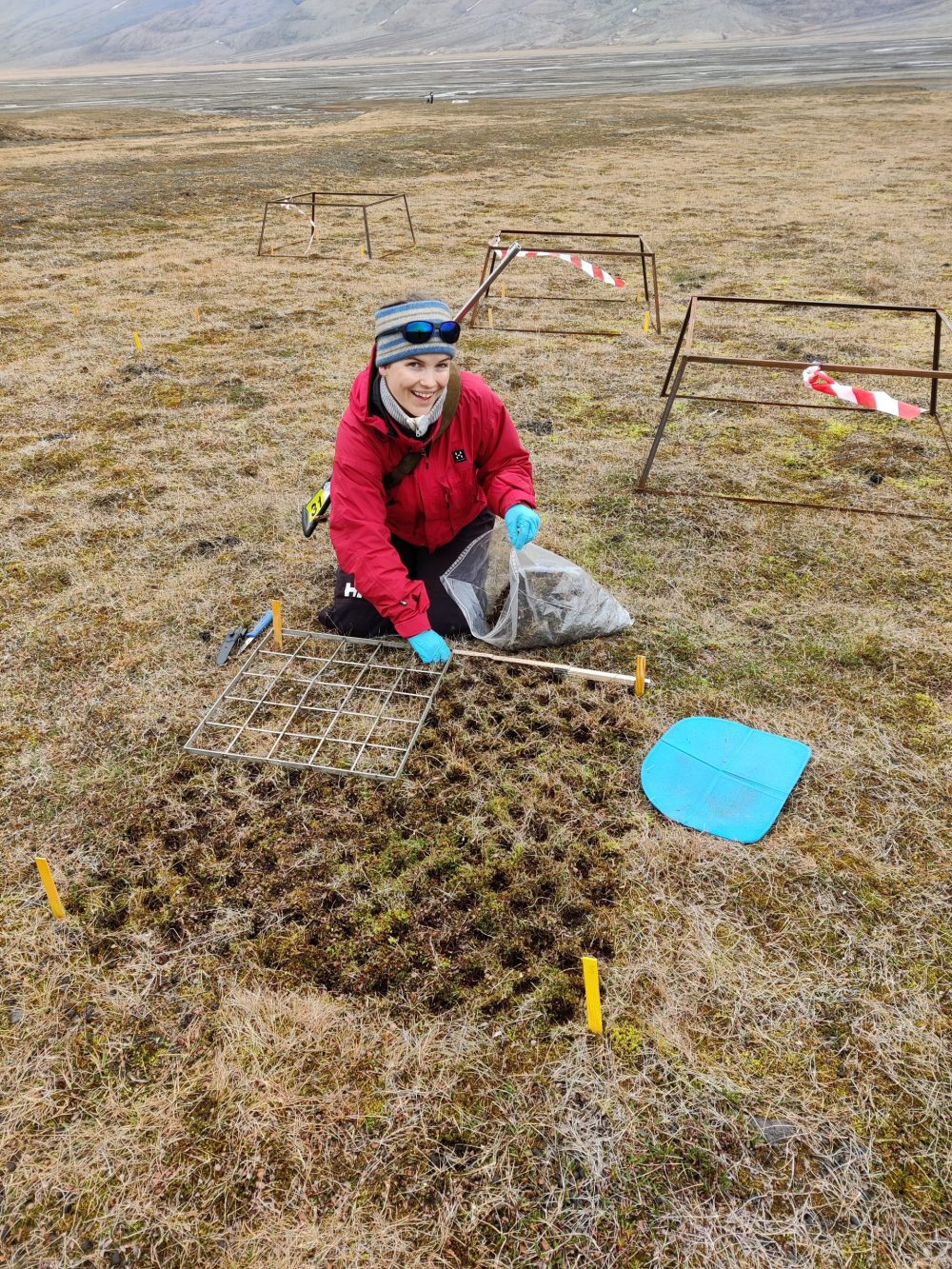Studying soil invertebrates in a High Arctic set up
Hello, my name is Fredrik Selmer, and I am going to tell you a bit about myself, how I ended up in TERRA and about the Arctic soil invertebrates.
So first, I am a biology master’s student at the Norwegian University of Life Sciences (NMBU), but I am doing my master’s thesis at Svalbard, under a quartet of supervisors, one of them being Emelie Winquist, and another being Simone I. Lang. This is my second time living in Svalbard. My first longer stay was as part of my biology Bachelor where I took the biology fall classes at UNIS. UNIS and Longyearbyen has an amazing social community, with a LOT of different clubs, spare time activity groups and so on. It is a place where it is very easy to get to know people and where ‘everybody know everybody’. The place is so set up for social encounters that the student housing doesn’t even have any proper separation between the different student kitchens, allowing for easy visits to all your student neighbours. The University Centre also has a lot of professors in relation to students, and professors who in general engage with the students, inviting them to join their own projects and who in general are interested in them. All this made UNIS and Svalbard a very welcoming and warm place to be, which together with the absolutely AMAZING wildlife and nature, made me want to stay as long as possible. I therefore applied for the marine biology spring class and management class despite having no prior knowledge in either subject, and I was allowed to stay until the spring of 2022. While engaged in the bachelor courses, I was also engaged in several BioCEED endeavours, one of them being an internship where I was partaking in the establishment of the TERRA field sites. After ending my TERRA internship and biology batchelor, it was time to start my biology master. I contacted UNIS looking for a thesis, and they wondered if I would be interested in partaking in an expansion of the TERRA project. The TERRA project was at this time looking into most of the different tundra biology aspects, mycology, botany, microbiology etc, but not soil invertebrates, so they wanted me to include those into the project. To this proposal I of course obliged. One year later, the spring of 2023, I was once again working on the TERRA field site. I continued doing this work throughout the summer and fall. The work included tasks like setting up and taking down anti goose grubbing cages / weather stations and open top chambers (OTCs), taking samples, and working with the HOBO data loggers. During the summer I also extracted a number of soil cores from the field site, as well as a collection of leaf litter samples. These cores and samples were to be used in order to look at the soil invertebrates and soil invertebrate induced leaf litter decomposition.
But why are we interested in the soil invertebrates and why are they important? But maybe more importantly to mention first; What are the soil invertebrates? So, in any soil you will find invertebrates; small insects, worms or insects or worm-like creatures, who live their whole life or at least part of it in soil. Two of the larger non insect groups are the mites and the springtails. The mites we now talk about are but very distant relatives of the more famous ticks and are mostly harmless to humans. They come in an enormous variety, about 45 000 species are known in the world, and there might be as much as a million species of mites in total. The species that live in soil are largely detritivores, or predators that feed upon other small invertebrates. But with this enormous diversity, you find mites occupying a vast number of different niches, and that these animals have a number of different effects upon the soil. Of particular interest to the TERRA project, is that these animals have effects upon how fast plant material rots within the soil, and how well plants access the nutrients stored within the soil. Both may affect the plant community composition of the tundra, and its carbon storage.
The springtails are relatives of the insects but not insects themselves. They are small, generally soft bodied, and often have a furcula, an organ that allows for some spectacular jumps, hence the name springtail. These animals are also diverse, yet not so much as the mites, with about 6500 species described. These animals are also important for soil health and decomposition for instance through their interactions with fungi.
Svalbard may look like a desolate desert on the surface, and it is, but it still harbours about 1000 species of invertebrates, 68 of these being springtails, and 179 being species of mite. And though the species count is relatively low, these animals may still reach astounding numbers. At Svalbard is it found that a single square meter of land can hold as much as 81000 individuals of Oribatid mites (a suborder of mites), and in another instance as much as 268 000 individuals of springtails. Even though the average is much lower than these extremes, there is still no doubt an incredible number of animals spread over the archipelago as a whole, indicating a need to gain a deeper understanding about these animals and the services they provide.
The Arctic environment is changing, there are increases in temperature, for instance shown through the increase in winter rain weather, and subsequent icing, and this will all likely affect the soil invertebrates. As well as the climatic changes also Svalbard’s geese populations are booming. These geese dig up the Arctic tundra, potentially changing the small air pockets in the soil that many soil invertebrates use as habitat, and thus exposing the animals for more severe climate effects as they remove the vegetation layer that otherwise would have protected the soil. It is important to study how these animals may fare under these new conditions.
The TERRA project aims to do this, studying how climate changes, and geese population increases, may affect the soil invertebrates and the decomposition they facilitate. And for this reason, leaf litter bags were dug up, and soil cores taken. The leaf litter bags will allow us to investigate the differences in decomposition between leaves only exposed to microbes, and ones that were also exposed to invertebrates. The mesh bags that the leaves were buried in prohibited invertebrates from interfering in the control batch. The soil cores were used to investigate how the animal counts varies between the plots exposed to different treatments, so that we could see if for example icing had reduced the number of animals compared to non-icing plots. The animals were extracted using a MacFayden extractor, a machine that uses heat to “chase” the animals out of the soil core and into a funnel, that leads to a collection tube. The animals are then later counted and identified using a microscope, a process that has taken most of the fall.
I am currently finishing my data analysis of the animal numbers and have just started writing on my master’s thesis. The hope being that we soon will gain some more understanding of how the Arctic changing climate, and increasing goose populations affect the Arctic tundra systems, with its plants, fungi, microbes, and invertebrates.
Fredrik Selmer
A Summer in Svalbard
Hello, I’m Clara Wilcock, a 23-year-old French. Last summer, I spent several months in Svalbard, a place where nature’s beauty and harshness intertwine. Svalbard is known for its unique landscape, rich wildlife, and the critical research taking place there. In this post, I’d like to share my experiences of this remote Arctic Archipelago as I have now completed the third year of my Bachelor’s degree in conservation biology.
My journey in Svalbard was made possible through the TERRA project working alongside the talented Ph.D. candidate Emelie Winquist. One of the core objectives of the TERRA project is to assess the impact of climate change on Arctic ecosystems. For my bachelor’s dissertation, I focused on the effects of goose grubbing, rain-on-snow events, and warming on soil decomposition.
My time in the field was an unforgettable experience. I participated in a range of activities, from measuring snow depth and RAM sonde snow hardness to handling Plant Root Simulator probes, Open Top Chambers, Tiny Talks, and HOBO loggers. I also conducted vegetation observations for another project conducted in the Reindalen valley south of Longyearbyen and compiled data sets.
Living in such an extreme environment required learning new skills, including essential ones for polar bear safety and the use of rifles during fieldwork; crucial “accessory” during our fieldwork. It’s a thrilling but crucial part of life in Svalbard.
What made my stay in Svalbard particularly extraordinary was the transition from sunny winter in April to the beginning of autumn in late August. At the start, we enjoyed fun excursions on snowmobiles and snowy hikes, with the beautifully white arctic landscape. With summer arriving whale watching became a popular activity, with boat trips and hikes showcasing the unique beauty of the midnight sun.
During my stay, I was fortunate to witness the rich diversity of Arctic wildlife. From the Svalbard reindeer and Arctic fox to the rock ptarmigan and the iconic polar bear. I also marveled at the enchanting seal and walrus sightings, but the true highlight was witnessing the minke and humpback whales the true giants of the Arctic oceans.
Before my summer in Svalbard, I lived in the lively city of Lyon. The shift to Longyearbyen was a welcomed change. The town’s warm and tight-knit community offered a sense of relaxation and calm that I hadn’t experienced before.
The ever-changing landscapes and the abundance of Arctic wildlife left a profound impact on me. Svalbard may be unforgiving in nature, but it is also the most peaceful places I have ever had the privilege of visiting. The conservation work conducted here is of paramount importance, and I’m grateful to have been a part of it. As I continue my academic journey in conservation biology, my time in Svalbard will forever serve as a reminder of the beauty and fragility of our natural world. As I look back on this journey, something tells me I’m not quite done with Svalbard. I hope to return someday soon.
Clara Wilcock
Second field work season!
We had another busy summer in the field!
Our intern Clara Wilcock helped a lot the whole summer season, and it was amazing to not only have help but also company both in the field and the lab. She will soon write a blog post about her internship!
Our master's student Fredrik Selmer has also been of great help. He started working on the project in May, with the focus on invertebrate decomposition, and he will also have a blog post about it soon.
The summer season started in early June with harvesting the first batch of decomposition bags and plant root simulator probes (PRS probes from Western AG) that I mentioned in my last post. This happened as soon as the ground had thawed, and the PRS probes were washed with MQ-water and a soft toothbrush in the lab within a few days from harvesting. The litter from the litterbags were transferred into small paper bags, so called “coin bags” and dried. The dry litter was then weighed by Clara and will be compared to the initial weight. The second batch was harvested in the beginning of September, and the same methods as described earlier applied. The decomposition dataset is the data from the first PhD study, and the data analyzing is about to start.
This summer we also had two weather stations in the field, one close to the moss site and one close to the dryas sites, to get additional weather data. They seemed to work quite well, and we got them down just in time for the reindeer rutting season, so they are still intact and can be used next year as well. That is more than can be said about the HOBO data loggers that we have used to log soil moisture. We have been very unlucky with them this year, and almost a third of them drowned in the snowmelt this spring, because of unusually large amounts of snow, and some of them got destroyed by reindeer in early September due to the rutting season. Last year the reindeer did not go for the HOBOs at all, but rather the metal exclosures that we have covering the plots, but this year it was the other way around. It is very difficult to predict what they will go for. Winter also came very early this year and we didn´t have time to download the tinytag temperature data from the ground before the ground froze, so it was very tricky to find the loggers in the frozen and in some parts ice-covered ground. We managed to find most of them, but the rest of that data must be downloaded when the ground has thawed. It is very important to have “Arctic flexibility” when it comes to research here, because things change all the time!
The biggest field and lab campaign this summer was my N15 study. In early July Clara and I injected N15 labelled ammonium in 9 points in an area of 20 x 20 cm in the upper right corner of the 60 research plots. We also installed 20 extra 20 x 20 cm plots in close relation to our research sites for natural N15 analysis, since it is a substance that we naturally have in the environment. After 2 weeks all the living vegetation in all the research plots and extra plots was harvested. Two 20 cm long soil cores of a diameter of about 6 cm were taken in every plot, making up to 160 soil cores in total. After this the harvested vegetation was sorted into species in the lab, except for grasses that we just put together since we were running out of time. Roots were taken out of the soil cores and sorted by size, and 4 different soil samples were taken. These were a microbial sample, that went straight into the –80 freezer. A fresh weight/dry weight sample, a sample for water extraction, and a sample for chloroform fumigation following a water extraction. These samples will be taken to Anders Michelsen at the University of Copenhagen for further analysis, and we hope for some interesting results!
Both the field work and the lab work were super intense because everything had to be processed as fast as possible, but we managed with the help of interns and volunteers. Once again, a big thank you to everyone who helped!
The last thing we did in early September was to insert the ingrowth bags for my last study in the field. Every plot got 4 small cylindrical bags with 40 g of acid washed quartz sand. Two of them will be harvested in the early Summer and the last two in Autumn.
I have also been working on science outreach this summer on an Instagram account called “terra_svalbard”, with weekly updates on what I have been doing. TERRA will be presented at the SCOPE conference at UNIS next weekend, and the N15 project will be presented with a poster both at SCOPE and at Svalbard Science Conference 2023.
All in all, we accomplished a lot this summer, and the project is going according to plan!
Emelie
Zoé Moskwiak, an intern at UNIS
Curious about what it looks like to be an intern in a research project at UNIS?
This is a short interview with Zoé, an intern working with Emelie during spring 2023
Can you shortly introduce yourself?
My name is Zoé Moskwiak, I’m 24 years old, and I come from Belgium. I enjoy learning new things and understanding how nature works, that’s why I decided to study biology. Moreover, I love outdoor sports like hiking, running, and cycling and I am always amazed by the landscapes I can see. I also love travelling and discovering new places.
What are your research interests (background)? What do you study at your home university?
For the last two year, I have been pursuing a Master in organisms and ecology at UCLouvain, in Belgium. I did my Master’s thesis last year on the impact of light pollution, and of the tree cover, on the effect that the phase of the lunar cycle can have on moths’ diversity.
What is your internship about? What are you hoping to gain for experience?
As an intern, I’ve been mainly helping in two projects so far.
For the first one, I’m helping a Master student to count reindeers and make snow measurements. His Master’s thesis is a part of a study about gradient that has been going on for several years (Bjørndalen Integrated Gradients (BIG)).
The second one is the Terra project. Since it’s still winter, I’m mainly helping with practical things in order to prepare the experiments that will take place this summer. For example, lids were made for the exclosure, and they were taken out to the field. Ingrowth bags were also made.
I’m so happy to have the chance to learn how the arctic ecosystem works. I’m used to forest, and fields, and having the opportunity to work here is awesome. I’m also learning a lot about fieldwork logistics and the setting up of experiments.
What strike you the most about living and working in the High Arctic?
Thinking that I live in the northernmost city is fantastic. A lot of people didn’t know where Svalbard was until I told them. When I showed them where it was, they were so impressed, because it’s so north! Life here is so different, everybody is nice.
Tell us about your favourite field experience so far!
I love the fieldwork here because it’s so different from what I know. The landscapes are wonderful, and you can work with reindeers only a few metres away. Working in so much snow without freezing, even if it’s really cold, is such a strange feeling.
Can you describe a typical weekend in Svalbard?
Since one day of the weekend is taken with the reindeer count, I usually use the other day to rest, to read a book, and to clean my room. Sometimes, I wander around the shops in town.
Can you come up with 4 words to describe of the wild nature in Svalbard?
White, wilderness, harsh, peaceful
Zoé was interviewed by Hélène Barthelemy (Spring 2023)
First impression, moving to Svalbard for my PhD studies…
Hi,
Welcome to this blog about the TERRA project and what it is like to do terrestrial research on Svalbard. My name is Emelie Winquist and I have moved up here from Finland in May 2022 to do a PhD in Arctic Terrestrial Biology.
During my first month on Svalbard the weather changed from cold snowy winter to arctic summer in only a few weeks. The temperatures rose from –10 to +10, and everyone was talking about the exceptionally high temperatures. I realized that I was witnessing the very thing I had read so much about during my studies in Climate Change.
Now when I am writing this post, it is the beginning of March, the month that should be one the coldest, and we just had plus degrees some weeks ago. Climate change is visible in our daily lives up here, and it is terrifying.
Svalbard is an incredibly beautiful, and isolated place. The mountains are amazing, and without any trees, you can see very far. The vegetation here is low growing and sparce, but the small flowers in the summer give so much colour to the otherwise greyish landscape. It teaches you to pay attention to the small changes. Talking about colours, the autumn colours here are amazing, and they turn whole valleys into a yellow and red colour. There is a word for this in Finnish, ruska, which describes this amazing autumnal event. Of course, the summer here is very short, and both the flowering and the ruska period is there for short, but very appreciated by both locals and tourists.
The wildlife on Svalbard is very different from anywhere I have ever been. During my fieldwork last summer, I was often surrounded by curious young wild reindeer, or Arctic skua`s coming to see if I was threatening their territory. I haven`t yet seen a polar bear, but there was a week in the autumn when I wasn't allowed to go out on fieldwork because there was a polar bear mom and her cub in the area around our research plots.
It was a big change to move to a small, isolated town from a capital city, but I have liked it very much. In a small town the pace of life is slower, since everything is so close, and the things you can do is limited. You can also make new friends more easily, because you run into the same people everywhere, and there is a lot of activities going on. I really can`t see myself living in a big town after living here.
I had a very quick move up to Svalbard, in only one month I gave up my apartment and the two jobs that I was working by the time and moved up. I had never been on Svalbard before moving up, which for many people was weird because most people that move up here have at least visited before. After the move, I quickly read up on the planned project and as soon as the snow melted, I started setting it up. The research plots had been chosen the year before, which helped a lot with the process of getting started. Open top chambers for simulation of warming and exclosures to keep the geese out were built. We simulated goose grubbing and installed temperature and soil moisture loggers in the plots. We did vegetation recording in the lower right corner of all plots, just to get an overview of what species we have, and when senescence hit, I collected a lot of leaves for my litter bag study. The leaves were put into mesh bags and dug down in the ground together with PRS plant root simulator probes. The first batch of litter bags will be taken up in the beginning of this summer, which is very exciting!
The time here has passed quickly, I cannot believe that I have been here a year soon, and that one third of my PhD has passed. It has been busy setting up the experiment, and I am so happy to now finally have time to start blogging and telling you more about my work and life here on Svalbard.
How this project came together
Coming soon! Stay tuned!
